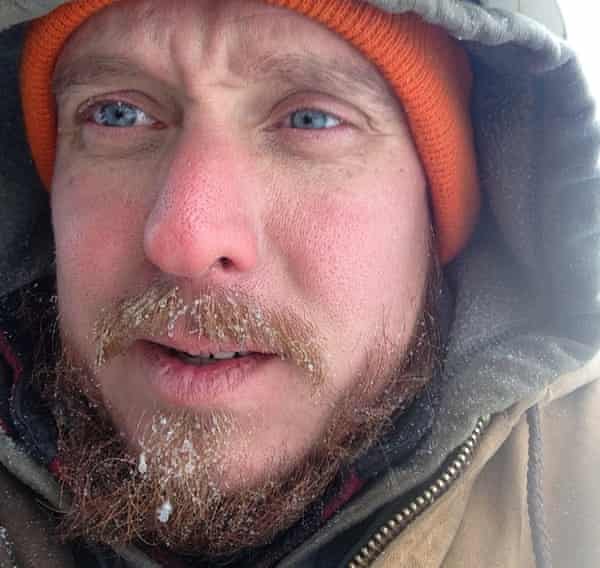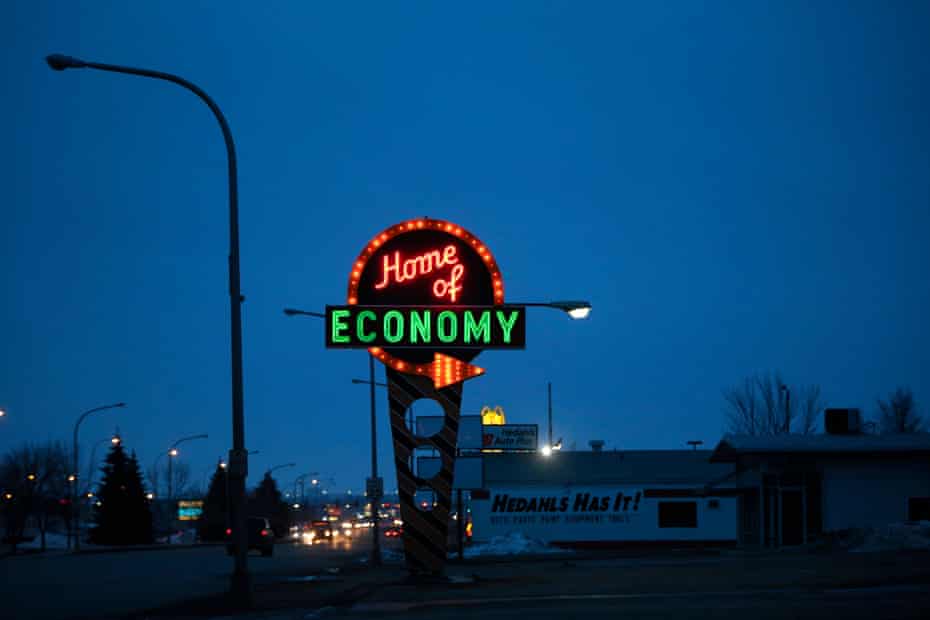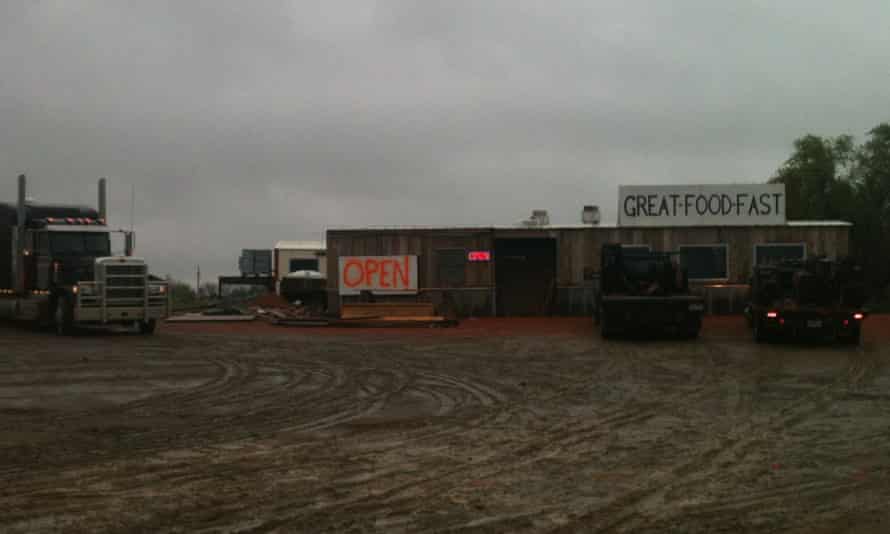Life in a modern boomtown is living on the frontier but with a smartphone. “Capitalism on crack” is the way historian Clay Jenkinson referred to it – everyone taking what they can get, as fast as they can.
I spent nearly a year in an oil boomtown: from summer of 2013 to winter of 2014, I worked in the Bakken oil patch out of Williston, North Dakota. At the time, politicians, geologists, and much of the national media claimed the town would be booming for decades to come. They were all wrong.
North Dakota began to boom in the midst of America’s forever wars, when technological advancement in horizontal drilling and hydraulic fracturing made a formerly impenetrable seam of crude oil suddenly recoverable.
Williston, a rural community in an Indian service area with ties to the Turtle Mountain Chippewa, found its population ballooning. Most of those coming to town were men looking for work. Much of the hiring by oilfield companies was pitched toward veterans, but in the wake of the 2008 crash, anyone who could swing a hammer had a shot at landing a job. Williston was swamped by out-of-work carpenters, plumbers and contractors of every stripe.

At the beginning of the boom, many oilfield jobs had provided signing bonuses, housing and per diems to the ever growing migrant workforce – benefits trumpeted by the oil industry, the media and local lawmakers. By the time I arrived, however, the perks had mostly dried up. I wasn’t the only guy late to the party.
The roads were cluttered with clunkers with out-of-state license plates, 18-wheelers, and construction crews. Under the yawning blue of the endless sky and cradled by rambling waves of prairie grass on either side of it, the busted macadam of Route 2 existed as the most visible mundane daily reminder that everything and everyone was a bit overwhelmed.
The Williston job services office estimated at the time that eight new people were arriving in town every day. Williston grew from 12,000 to over 30,000 residents in a few short years, according to some estimates. Most likely those estimates are low. At one point, the town’s mayor claimed Williston was providing services to as many as 60,000 to 70,000 people.
Some of the men I worked with were locals but a great deal were migrant workers like me, general laborers willing to follow the money, or so hard up that “willing” didn’t enter the equation. Migrant workers had come not only from the heartland, but from everywhere. I lived with a group of Jamaicans, and worked with several Congolese immigrants. Several guys I knew had worked the silver mines in Elko, Nevada, then moved to Williston when the price of silver dropped. I imagine many of them drifted down to Texas to work the Permian once Williston went bust. Before I met them, I thought of these kinds of transient workers as a relic of the dust bowl. I didn’t know they still existed. Now I think about them every day.
17-hour shifts
I landed a job at a crane rigger and swamper for a company that moved oil rigs. I feel stumped every time I attempt to find an adjective that captures how hard the work was. An average day in the patch runs between 12 and 14 hours, much of it back breaking. While many oilfield jobs required two weeks on and two weeks off, I was on call every day. On days off, I sometimes didn’t leave the bed, just lay there staring up at the ceiling, the worry in my belly tightening like a metal coil, waiting for a call from dispatch saying “You’re headed out on the gin truck tomorrow, Magic.” My longest work day was 17 and a half hours. The longest week I recorded working was 95 and a half hours. I once worked 172 hours over the course of 14 days. To the men I worked with, this was unexceptional.

It was considered bad form to show how much you were struggling on the job. Guys got run off for looking weak or operating a step behind. I worried over my lack of size, strength and skill. It wasn’t until I’d earned my place in the patch that one of the toughest hands I knew admitted that for his first several months on the job, he used to go home and cry every night.
We worked through all kinds of weather. From the 99F dog days of summer to deep into North Dakota’s bracing winter storms. The coldest I ever worked in was -38F. I was never provided cold weather gear by the company I worked for, although I asked for it multiple times. Frostbite was not uncommon. One guy joked that you could tell a real oilfield hand by the fact he was missing the fleshy part toward the tip of his nose. There was always a lot of talk about real oilfield hands. Pride was one thing no one can take from you out there.
‘Boomtowns find ways to take your money’
“You made a lot of money, though, right?” Is usually the question I get asked right about now. I hate to admit it, but I did not. I was paid $21.25 an hour. I got a lot of overtime, but frankly, I find the economist’s habit of conflating an average of 70 hours a week of heavy manual labor to 40 hours a week of office work to be – if not purposefully designed to minimize the sacrifices of working people – than at the very least, wildly ignorant.
Boomtowns by design find ways to take your money as fast as you make it. When large amounts of cash flood a small town in an incredibly short period of time, a kind of localized hyperinflation occurs. The most precious commodity in Williston, outside oil, was housing. In 2013, rents in north-west North Dakota surpassed those of San Francisco to become the most expensive in the nation. When I first arrived I paid $450 a month for a mattress on the floor of a living room, which I shared with four other migrant men in a small townhouse packed with as many as 12 people. It was the best deal in town.
Inflated prices affected every aspect of life. Lunch at a truck stop could cost me $30. Shops and restaurants had trouble staying staffed. Famously, workers at Williston’s Walmart gave up on stocking the shelves. A local diner took to stacking applications by the register with a sign saying “Complaints? Take one.” When my truck broke down, it took me two months to get a mechanic to look at it.

There was a shortage of hospital workers, teachers and cops. A thriving black market developed. Sex workers set up at motels, advertising hourly rates on Craigslist. Sex trafficking became a big problem in a small town. America’s current crisis of missing and murdered Indigenous women has been tied to the prevalence of man camps, a common feature of modern boomtowns. Crime in general escalated. Police officers reported increases in alcohol-related and drug related crimes, property and traffic crime, domestic violence and prostitution. Some statistics appear to support the idea that the crime increase was unremarkable as it simply mirrored the population increase, but this misses the point. The Williston police department had 22 officers on staff in 2007 and received 4,579 calls for service. By 2010, calls for service had increased to 16,495 and they’d only hired two more officers. There weren’t enough cops. Officers reported an inability to offer “community policing” and an increase in “reactive policing.” The small town force adopted a more militarized style of policing.
Boom to bust
In many ways, every boomtown is alike. Had a teamster from 1860s era Pithole stepped through a time warp and found himself and his mule clopping down Route 2 in Williston in the late 2000s, he would no doubt have recognized some of what he saw.
Pithole, in western Pennsylvania, in an area then known as “Oildorado” was America’s first true oil boomtown. Accounts from the period tell the story of Coal Oil Johnny, a dimwitted young man made rich by oil overnight. Johnny hosted parties that “outstripped even the Roman orgies”. When he saw a play he liked, he bought the theater troupe. Tired by the rigors of travel, like a modern-day one-percenter would a Learjet, Johnny bought a train.
Ben Hogan, a former prize fighter and murderer, operated Pithole’s biggest brothel with his mistress French Kate and a revolving door of “soiled doves,” – sex workers known by names of “Dolly the Swede,” “Champage Mamie,” and “Lizzie Toppling.” Time has a way of neutering the darker details of history and making the terror sound quaint and fun. But don’t let the cute names fool you. John Wilkes Booth was an early investor in oil. Before he murdered a president, he could be found in Pithole’s taverns declaiming soliloquies from Richard III.

By the end of the civil war, Oildorado was flooded by veterans of both the blue and gray. The Union General MH Avery rode directly from Lee’s surrender at Appomattox to Pithole where he put his cavalry skills to use by organizing a train of teamsters.
Since Pithole, oil has completely transformed human existence. From transportation to textiles to pharmaceuticals to farming, petroleum has become the basic building block for every facet of modern life. Boomtowns have powered that transformation. Like wrenches and drill bits, these towns are best thought of as instruments meant to assure the utmost efficiency in removing valuables from the earth while gaining the most possible profit. They are not a bug in big oil’s business model. They are not a flaw. They are a feature.
Boomtowns bust when the resource dries up or becomes too expensive to extract and the work leaves town. Williston went the way of every other of America’s legendary boomtowns. The majority of wealth generated was funneled out of the local community with migrant workers sending money home, the low cost of oil primarily benefiting wealthier urban and suburban areas, and profits spilling upward into the pockets of the world’s richest. Williston natives had seen it all before.
Before the 2000s, Williston boomed in the 1970s. One friend of mine, a Williston native, joked that between the booms, he’d looked for jobs by going through the obituaries. Another hand told me that during that same period he had taken to poaching, illegally hunting to put food on the table for his family. Oil companies have used this business model for more than 150 years.
I left Williston in 2014, my belongings loaded up into my Ford Ranger pickup. I was heading back east to return to what I hoped would be a simpler, less dangerous life.

My move was well timed. Despite the optimistic projections that the state would add over 13,000 jobs in 2014, and nearly 30,000 by 2020, the number of active drilling wells in North Dakota dropped from a high of 195 to a low of 64 when the price of oil plummeted from $107.95 a barrel in June 2014 to $44.08 a barrel seven months later. Companies laid off workers, migrants fled, and support businesses shuttered. North Dakota went bust. Had I decided to stay, I would have been out of a job within a year regardless.
It is impossible to say how many individuals found financial success during Williston’s boom. I know I didn’t. I left town with less cash than I’d arrived with. Admitting that makes me feel dumb, but I’m hardly the only one. Most people I met during the boom could be described as poor or lower middle class. Many of us bought nicer stuff during those years, and some of us I know used the money they made to transition into more stable work. That said, it would be hard for me to name a person who somehow changed their station in life, who used the boom to grab a higher rung on the ladder of the American dream. I am absolutely certain however that, as it is apparently impossible for them not to in our current economic system, that the rich got richer.
The cost of oil extraction
The broken down bodies of generations of oil workers are one testament to the world of oil extraction, so are blazing forests and soupy glaciers.
The History of Pithole, written by a wounded civil war veteran turned newspaper reporter called Crocus, devotes an entire chapter to the multitude of fires that razed the town.
“The month of April 1866,” he writes “was noted for its many and disastrous conflagrations.
-
2 April, Oil Refinery of Battles, Vorce & Co burned; also two wells upon the Rooker farm.
-
3 April, Fire on Holmden street. Utica House, grocery establishment and shoe shop burned. Loss $5,000.
-
9 April, Old Holmden house and bath rooms of J Shieve destroyed. Loss $5,000.
-
10 April, Tanks of Titusville Pipe Company burned, with large amount of other property, including engines, derricks, &c. Loss $20,000.
-
14 April, Refinery of Van Horn & Co, on lease 110 Thomas Holmden farm, wells 107 and 108 Holmden, and 13 and 14 Rooker farm, destroyed by fire. Loss $16,0000.
-
20 April, Great fire on First street. Eighteen buildings burned including the following hotels: Cumberland House, Eckert House, Globe Hotel, Oil City House and Center House. Loss $30,000.
-
23 May, Balltown nearly destroyed by fire. Total loss $135,000.”
The remorseless list, notable for its lack of humanity and relentless financial accounting, continues like a litany. The Biden administration is currently attempting to stop the fires that started in Pithole, making the boldest push to move away from fossil fuels and confront the climate crisis in the history of this nation. The administration faces enormous hurdles.

If sustainable green technology is the future, and surely we must hope that it is, then it needs to provide sustainable, good paying jobs – something that frankly the oil companies have advertised much more than they ever bothered to deliver.
Oil is never going away completely. Therefore, oilfield workers should be more highly compensated. The industry should be forced to put real money into extractive communities instead of treating them as tools that they toss out as soon as they are done with them. Not everything needs to be a cash grab. Not all the money needs to go to the top.
As a nation, we should take better care of our extractive communities. People in towns like Williston, North Dakota, have been on the frontlines of energy extraction in some cases for longer than a century. The developing green energy industry should be incentivized to put new, sustainable jobs in extractive communities. Much like our soldiers coming home from overseas, the workers and families in these towns deserve our gratitude, our respect and our investment.
Michael Patrick F Smith is a former oilfield hand and the author of The Good Hand (A Memoir of Work, Brotherhood, and Transformation in an American Boomtown). This essay is adapted from his 19 May testimony before the oversight and investigations subcommittee of the natural resources committee of the United States Congress.